Game of Thrones
Game of Thrones
"GoT" redirects here. For other uses, see GOT.
This article is about the TV series. For other uses, see Game of Thrones (disambiguation).
Game of Thrones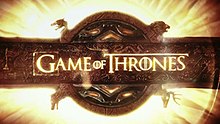 Title card for the first seven seasons
Title card for the first seven seasons
Based onA Song of Ice and Fire
- by George R. R. MartinStarringsee List of Game of Thrones charactersTheme music composerRamin DjawadiOpening theme"Main Title"ComposerRamin DjawadiCountry of originUnited StatesOriginal languageEnglishNo. of seasons8No. of episodes73 (list of episodes)ProductionExecutive producersDavid Benioff
- D. B. Weiss
- George R. R. Martin
- Carolyn Strauss
- Frank Doelger
- Bernadette Caulfield
- Bryan Cogman
- Miguel Sapochnik
- David Nutter
- ProducersMark Huffam
- Joanna Burn
- Chris Newman
- Greg Spence
- Lisa McAtackney
- Duncan Muggoch
- Production locationsUnited Kingdom
- Croatia
- Iceland
- Spain
- Malta
- Morocco
- Canada
- Running time50–82 minutesProduction companiesHBO Entertainment
- Television 360
- Grok! Television
- Generator Entertainment
- Startling Television
- Bighead Littlehead
Original releaseNetworkHBOReleaseApril 17, 2011 –
- May 19, 2019RelatedThronecast
- After the Thrones
- House of the Dragon
Game of Thrones is an American fantasy drama television series created by David Benioff and D. B. Weiss for HBO. It is an adaptation of A Song of Ice and Fire, a series of fantasy novels by George R. R. Martin, the first of which is A Game of Thrones. The show premiered on HBO in the United States on April 17, 2011, and concluded on May 19, 2019, with 73 episodes broadcast over eight seasons.
Set on the fictional continents of Westeros and Essos, Game of Thrones has a large ensemble cast and follows several story arcs throughout the course of the show. The first major arc concerns the Iron Throne of the Seven Kingdoms of Westeros through a web of political conflicts among the noble families either vying to claim the throne or fighting for independence from whoever sits on it. The second focuses on the last descendant of the realm's deposed ruling dynasty, who has been exiled to Essos and is plotting to return and reclaim the throne. The third follows the Night's Watch, a military order defending the realm against threats from beyond Westeros' northern border.
Game of Thrones attracted a record viewership on HBO and has a broad, active, and international fan base. Critics have praised the series for its acting, complex characters, story, scope, and production values, although its frequent use of nudity and violence (including sexual violence) generated controversy. The final season received significant criticism for its reduced length and creative decisions, with many considering it a disappointing conclusion. The series received 59 Primetime Emmy Awards, the most by a drama series, including Outstanding Drama Series in 2015, 2016, 2018 and 2019. Its other awards and nominations include three Hugo Awards for Best Dramatic Presentation, a Peabody Award, and five nominations for the Golden Globe Award for Best Television Series – Drama.
A prequel series, House of the Dragon, premiered on HBO in 2022.
Premise
Plot
See also: Synopsis of A Song of Ice and Fire and World of A Song of Ice and Fire
Game of Thrones is roughly based on the storylines of the A Song of Ice and Fire book series by George R. R. Martin, set in the fictional Seven Kingdoms of Westeros and the continent of Essos.[5][6] The series follows several simultaneous plot lines.[7] The first story arc follows a war of succession among competing claimants for control of the Iron Throne of the Seven Kingdoms, with other noble families fighting for independence from the throne. The second concerns the exiled scion's actions to reclaim the throne; the third chronicles the threat of the impending winter, as well as the legendary creatures and fierce peoples of the North.[8]
Cast and characters
Main article: List of Game of Thrones characters
Game of Thrones has an ensemble cast which has been estimated to be the largest on television.[9] In 2014, several actors' contracts were renegotiated to include a seventh-season option.[10] By the final season, five of the main cast members made $1 million per episode, making them among the highest paid television performers.[11][12]
Eddard "Ned" Stark (Sean Bean) is the head of House Stark. He and his wife, Catelyn (Michelle Fairley), have five children: Robb (Richard Madden), Sansa (Sophie Turner), Arya (Maisie Williams), Bran (Isaac Hempstead-Wright), and Rickon (Art Parkinson). Ned also has an illegitimate son, Jon Snow (Kit Harington), who, along with his scholarly friend, Samwell Tarly (John Bradley), serve in the Night's Watch under Lord Commander Jeor Mormont (James Cosmo). The Wildlings living north of the Wall include Gilly (Hannah Murray) and the warriors Tormund Giantsbane (Kristofer Hivju) and Ygritte (Rose Leslie).[13]
Others associated with House Stark include Ned's ward Theon Greyjoy (Alfie Allen), Ned's vassal Roose Bolton (Michael McElhatton), and Roose's illegitimate son, Ramsay Snow (Iwan Rheon). Robb accepts help from the healer Talisa Maegyr (Oona Chaplin), while elsewhere, Arya befriends blacksmith's apprentice Gendry Rivers (Joe Dempsie) and assassin Jaqen H'ghar (Tom Wlaschiha). In the Stormlands, the tall warrior Brienne of Tarth (Gwendoline Christie) is introduced to Catelyn.
In King's Landing, Ned's friend, King Robert I Baratheon (Mark Addy), shares a loveless political marriage with Cersei Lannister (Lena Headey). Her younger twin brother, Ser Jaime (Nikolaj Coster-Waldau), serves on the Kingsguard while their younger brother Tyrion (Peter Dinklage) is attended by his mistress Shae (Sibel Kekilli) and mercenary Bronn (Jerome Flynn). Cersei's father is Tywin (Charles Dance), head of House Lannister and richest man in Westeros. Cersei has two sons: Joffrey (Jack Gleeson) and Tommen (Dean-Charles Chapman). Joffrey is guarded by the scar-faced warrior Sandor "The Hound" Clegane (Rory McCann).[14]
The king's Small Council includes his treasurer, Petyr "Littlefinger" Baelish (Aidan Gillen), and his spymaster, Varys (Conleth Hill). In Dragonstone, Robert's younger brother, Stannis (Stephen Dillane), is advised by foreign priestess Melisandre (Carice van Houten) and former smuggler Ser Davos Seaworth (Liam Cunningham). In the Reach, the Tyrell family is led by matriarch Olenna (Diana Rigg) and represented at court by her granddaughter Margaery (Natalie Dormer). The High Sparrow (Jonathan Pryce) is given power as a religious leader, while, in Dorne, the warrior Ellaria Sand (Indira Varma) seeks vengeance against the Lannisters.[13]
Across the Narrow Sea in Pentos, siblings Viserys Targaryen (Harry Lloyd) and Daenerys Targaryen (Emilia Clarke) (colloquially referred to as "Dany") are in exile, with the former plotting to reclaim his father's throne. Daenerys is forced into marrying Khal Drogo (Jason Momoa), a leader of the nomadic Dothraki. Her retinue eventually comes to include the exiled knight Ser Jorah Mormont (Iain Glen), her aide Missandei (Nathalie Emmanuel), mercenary Daario Naharis (Michiel Huisman), and elite soldier Grey Worm (Jacob Anderson).[13]
- Main cast and characters

- Peter Dinklage (Tyrion Lannister)
-

- Lena Headey (Cersei Lannister)
-

- Nikolaj Coster-Waldau (Jaime Lannister)
-
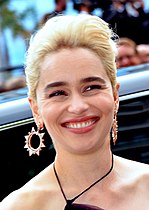
- Emilia Clarke (Daenerys Targaryen)
-

- Kit Harington (Jon Snow)
-

- Sophie Turner (Sansa Stark)
-
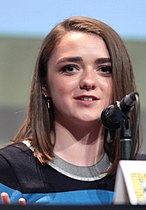
- Maisie Williams (Arya Stark)
-

- Isaac Hempstead Wright (Bran Stark)
-

- Iain Glen (Jorah Mormont)
-
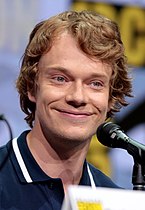
- Alfie Allen (Theon Greyjoy)
Themes
Main article: Themes in A Song of Ice and Fire
The series has been praised by both television critics and historians for what was perceived as a sort of medieval realism.[15][16][17] George R. R. Martin set out to make the story feel more like historical fiction than contemporary fantasy, with less emphasis on magic and sorcery and more on battles, political intrigue, and the characters, believing that magic should be used moderately in the epic fantasy genre.[18][19][20] Martin has said that, "the true horrors of human history derive not from orcs and Dark Lords, but from ourselves".[21] Academics have classified the series as neo-medieval which focuses on the overlapping of medieval history and popular fantasy.[22][23][24] A common theme in the fantasy genre is the battle between good and evil, which Martin says does not mirror the real world.[25] Martin explores the relationship between good and evil through the questions of redemption and character change.[26] The series allows the audience to view different characters from their perspective, unlike in many other fantasies.[20][27]
In early seasons, under the influence of the A Song of Ice and Fire books, main characters were regularly killed off, and this was credited with developing tension among viewers.[28] Martin stated in an interview that he wanted to depict war and violence in a realistic way, which sometimes mean the hero or main characters could be injured or killed.[29] In later seasons, critics pointed out that certain characters had developed "plot armor" to survive in unlikely circumstances and attributed this to Game of Thrones deviating from the novels to become more of a traditional television series.[28] In a 2012 study, out of 40 recent television drama shows, Game of Thrones ranked second in deaths per episode, averaging 14.[30] A scientific study conducted in 2018 stated that about 60% of the major characters died as a result of violence and war.[31]
Inspirations and derivations
Although the series's first season closely follows the events of the first novel, there were significant changes made for later seasons. According to Benioff, the TV adaptation is "about adapting the series as a whole and following the map George laid out for us and hitting the major milestones, but not necessarily each of the stops along the way".[32] Aspects of the novels' plots and their adaptations are based upon settings, characters, and events in European history.[33] Most of Westeros is reminiscent of high medieval Europe, from its geography and castles to its cultures, the feudal system, palace intrigues, and the knights' tournaments.[34][35] Like medieval Europe, most of the houses in the series use the patriarchal system of power.[36] The series also includes elements of gothic fiction, including torture tropes.[37]
A principal inspiration for the novels is the English Wars of the Roses (1455–1485) between the houses of Lancaster and York, reflected in Martin's houses of Lannister and Stark.[38] The scheming Cersei Lannister evokes Isabella, the "She-Wolf of France" (1295–1358).[33] She and her family, as portrayed in Maurice Druon's historical novel series, The Accursed Kings, were a main inspiration of Martin's.[39] Other historical antecedents of series elements include: Hadrian's Wall (which becomes Martin's Wall), the Roman Empire, and the legend of Atlantis (ancient Valyria), Byzantine Greek fire ("wildfire"), Icelandic sagas of the Viking Age (the Ironborn), the Mongol hordes (the Dothraki), the Hundred Years' War, and the Italian Renaissance.[33] The series's popularity has been attributed, in part, to Martin's skill at fusing these elements into a seamless, credible version of alternate history.[33][40]
Production
Conception and development
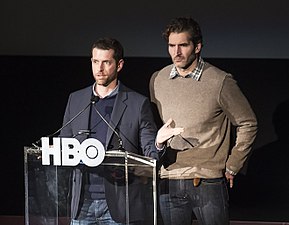 Showrunners D. B. Weiss and David Benioff created the series, wrote most of its episodes and directed several.
Showrunners D. B. Weiss and David Benioff created the series, wrote most of its episodes and directed several.
The A Song of Ice and Fire series of novels was popular before Game of Thrones.[41] The series has sold more than 90 million copies worldwide with the novels being translated into 45 different languages.[42][43] George R. R. Martin received multiple fantasy writing awards and nominations, including a World Fantasy Award and multiple Locus Awards, for the series.[44] Writing for Time magazine in 2005 after the release of A Feast for Crows, journalist Lev Grossman called Martin the "American Tolkien", stating he is a "major force for evolution in fantasy".[45]
In January 2006, David Benioff had a telephone conversation with Martin's literary agent about the books he represented. Having been a fan of fantasy fiction when he was younger, he became interested in A Song of Ice and Fire, which he had not read. The literary agent sent Benioff the series's first four books.[46] Benioff read a few hundred pages of the first novel, A Game of Thrones, shared his enthusiasm with D. B. Weiss, and suggested that they adapt Martin's novels into a television series; Weiss finished the first novel in "maybe 36 hours".[47] They pitched the series to HBO after a five-hour meeting with Martin (himself a veteran screenwriter) in a restaurant on Santa Monica Boulevard. According to Benioff, they won Martin over by knowing the answer to his question, "Who is Jon Snow's mother?"[48]
I had worked in Hollywood myself for about 10 years, from the late '80s to the '90s. I'd been on the staff of The Twilight Zone and Beauty and the Beast. All of my first drafts tended to be too big or too expensive. I always hated the process of having to cut. I said, 'I'm sick of this, I'm going to write something that's as big as I want it to be, and it's going to have a cast of characters that go into the thousands, and I'm going to have huge castles, and battles, and dragons.'
— George R. R. Martin, author[49]
Before being approached by Benioff and Weiss, Martin had had meetings with other scriptwriters, most of whom wanted to adapt the series as a feature film. Martin, however, deemed it "unfilmable", saying that the size of one of his novels is as long as The Lord of the Rings, which had been adapted as three feature films.[49] Benioff agreed it would be impossible to turn the novels into a feature film as their scale is too big for a feature film, and dozens of characters would have to be discarded. Benioff added, "a fantasy movie of this scope, financed by a major studio, would almost certainly need a PG-13 rating. That means no sex, no blood, no profanity. Fuck that."[20] Martin was pleased with the suggestion that they adapt it as an HBO series, saying that he "never imagined it anywhere else".[50]
The series began development in January 2007.[5] HBO acquired the television rights to the novels, with Benioff and Weiss as the series' executive producers and Martin as a co-executive producer. The intention was for each novel to yield a season's worth of episodes.[5] Initially, Martin would write one episode per season while Benioff and Weiss would write the rest.[5] Jane Espenson and Bryan Cogman were added later to write one episode each for the first season.[51] The first and second drafts of the pilot script by Benioff and Weiss were submitted in August 2007[52] and June 2008,[53] respectively. Although HBO liked both drafts,[54] a pilot was not ordered until November 2008.[55] The pilot episode, "Winter Is Coming", was shot in 2009; after its poor reception following a private viewing, HBO demanded an extensive re-shoot (about 90 percent of the episode, with cast and directorial changes).[48][56] The pilot reportedly cost HBO $5–10 million to produce,[57] while the first season's budget was estimated at $50–60 million.[58] For the second season, the series received a 15-percent budget increase for the climactic battle in "Blackwater" (which had an $8 million budget).[59][60] Between 2012 and 2015, the average budget per episode increased from $6 million[61] to "at least" $8 million.[62] The sixth-season budget was over $10 million per episode, for a season total of over $100 million, a record for a series's production cost.[63] By the final season, the production budget per episode was estimated to be $15 million.[64]
Casting
Nina Gold and Robert Sterne were the series' primary casting directors.[65] Through a process of auditions and readings, the main cast was assembled. The only exceptions were Peter Dinklage and Sean Bean, whom the writers wanted from the start; they were announced as joining the pilot in 2009.[66][67] Other actors signed for the pilot were Kit Harington as Jon Snow, Jack Gleeson as Joffrey Baratheon, Harry Lloyd as Viserys Targaryen, and Mark Addy as Robert Baratheon.[67] According to Benioff and Weiss, Addy was the easiest actor to cast for the series because of his audition performance.[68] Some characters in the pilot were recast for the first season. The role of Catelyn Stark was played initially by Jennifer Ehle, but the role was recast with Michelle Fairley.[69] The character of Daenerys Targaryen was also recast, with Emilia Clarke replacing Tamzin Merchant.[70] The rest of the first season's cast was selected in the second half of 2009.[71]
Although many of the cast returned after the first season, the producers had many new characters to cast in each of the following seasons. Because of the large number of new characters, Benioff and Weiss postponed introducing several key characters in the second season and merged several characters into one, or assigned plot functions to different characters.[9] Some recurring characters were recast over the years; for example, Gregor Clegane was played by three different actors, while Dean-Charles Chapman played both Tommen Baratheon and a minor Lannister character.[72]
Writing
 George R. R. Martin, author of A Song of Ice and Fire, is a series co-executive producer and wrote one episode for each of the first four seasons.
George R. R. Martin, author of A Song of Ice and Fire, is a series co-executive producer and wrote one episode for each of the first four seasons.
Game of Thrones used seven writers over its six seasons. Benioff and Weiss wrote most of each season's episodes.[73] A Song of Ice and Fire author George R. R. Martin wrote one episode in each of the first four seasons. Martin did not write an episode for the later seasons, since he wanted to focus on completing the sixth novel (The Winds of Winter).[74] Jane Espenson co-wrote one first-season episode as a freelance writer.[75]
Cogman, initially a script coordinator for the series,[75] was promoted to producer for the fifth season. Cogman, who wrote at least one episode for the first five seasons, was the only other writer in the writers' room with Benioff and Weiss.[73] Before Cogman's promotion, Vanessa Taylor—a writer during the second and third seasons—worked closely with Benioff and Weiss. Dave Hill joined the writing staff for the fifth season after working as an assistant to Benioff and Weiss.[76] Although Martin was not in the writers' room, he read the script outlines and made comments.[73]
Benioff and Weiss sometimes assigned characters to particular writers; for example, Cogman was assigned to Arya Stark for the fourth season. The writers spent several weeks writing a character outline, including what material from the novels to use and the overarching themes. After these individual outlines were completed, they spent another two to three weeks discussing each main character's individual arc and arranging them episode by episode.[73] A detailed outline was created, with each of the writers working on part of it to create a script for each episode. Cogman, who wrote two episodes for the fifth season, took a month and a half to complete both scripts. They were then read by Benioff and Weiss, who made notes, and parts of the script were rewritten. All ten episodes were written before filming began since they were shot out of order by two units in different countries.[73] Benioff and Weiss wrote their episodes together; one wrote the first half of the script with the other writing the second half. They then passed the drafts back and forth to make notes and do rewrites.[50]
Adaptation schedule and episodes
Main article: List of Game of Thrones episodes
After Game of Thrones story line began outpacing the published novels in the sixth season, the series was based on a plot outline of the future novels provided by Martin along with original content.[77][78] Before season four, Martin stated there was an issue with the television series being released before the source material could be written.[79] According to Benioff, Martin gave the showrunners an outline on the final two books of the series.[80] In April 2016, the showrunners' plan was to shoot 13 more episodes after the sixth season: seven episodes in the seventh season and six episodes in the eighth.[81] Later that month, the series was renewed for a seventh season with a seven-episode order.[82][83] HBO announced in June 2016 that the eighth season would be the final for the series.[84]
Game of Thrones adaptation and season scheduleSeasonOrderedFilmingFirst airedLast airedNovel(s) adaptedRef(s)Season 1March 2, 2010Second half of 2010April 17, 2011June 19, 2011A Game of Thrones[85]Season 2April 19, 2011Second half of 2011April 1, 2012June 3, 2012A Clash of Kings[86]Season 3April 10, 2012July–November 2012March 31, 2013June 9, 2013A Storm of Swords[87]Season 4April 2, 2013July–November 2013April 6, 2014June 15, 2014A Storm of Swords[88]Season 5April 8, 2014July–December 2014April 12, 2015June 14, 2015A Feast for Crows, A Dance with Dragons and original content[89]Season 6April 8, 2014July–December 2015April 24, 2016June 26, 2016Outline from The Winds of Winter and original content[90]Season 7April 21, 2016August 2016–February 2017July 16, 2017August 27, 2017Outline from A Dream of Spring and original content[91]Season 8July 30, 2016October 2017–July 2018April 14, 2019May 19, 2019[92]
The first two seasons adapted one novel each. For the later seasons, its creators saw Game of Thrones as an adaptation of A Song of Ice and Fire as a whole rather than the individual novels,[93] enabling them to move events across novels as the screen adaptation required.[94]
Filming
 The Azure Window at Ras-id-Dwerja, on Gozo, was the site of the Dothraki wedding in season one.
The Azure Window at Ras-id-Dwerja, on Gozo, was the site of the Dothraki wedding in season one.
The show was shot in the United Kingdom, Canada, Croatia, Iceland, Malta, Morocco, and Spain.
Principal photography for the first season was scheduled to begin on July 26, 2010;[95] the primary location was the Paint Hall Studios in Belfast, Northern Ireland.[96] Exterior scenes in Northern Ireland were filmed at Sandy Brae in the Mourne Mountains (standing in for Vaes Dothrak); Castle Ward (Winterfell); Saintfield Estates (the Winterfell godswood); Tollymore Forest (outdoor scenes); Cairncastle (the execution site); the Magheramorne quarry (Castle Black); and Shane's Castle (the tourney grounds).[97] Doune Castle in Stirling, Scotland, was also used in the original pilot episode for scenes at Winterfell.[98] The producers initially considered filming the entire series in Scotland, but decided on Northern Ireland because of the availability of studio space and tax credits.[99]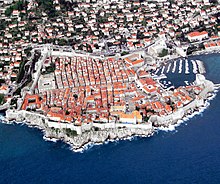 The walled city of Dubrovnik stood in for King's Landing in season two.
The walled city of Dubrovnik stood in for King's Landing in season two.
The first season's southern scenes were filmed in Malta, a change in location from the pilot episode's Moroccan sets.[95] The city of Mdina was used for King's Landing.[100] Filming also took place at Fort Manoel (representing the Sept of Baelor); at the Azure Window on the island of Gozo (the Dothraki wedding site); and at San Anton Palace, Fort Ricasoli, Fort St. Angelo and St. Dominic monastery (all used for scenes in the Red Keep).[97] Filming of the second season's southern scenes shifted from Malta to Croatia, where the city of Dubrovnik and nearby locations allowed exterior shots of a walled, coastal medieval city. The Walls of Dubrovnik and Fort Lovrijenac were used for scenes in King's Landing, though exteriors of some local buildings in the series, for example, the Red Keep and the Sept of Baelor, are computer generated.[101] The island of Lokrum, the St. Dominic monastery in the coastal town of Trogir, the Rector's Palace in Dubrovnik, and the Dubac quarry (a few kilometers east) were used for scenes set in Qarth. Scenes set north of the Wall, in the Frostfangs, and at the Fist of the First Men, were filmed in November 2011 in Iceland on the Vatnajökull glacier near Smyrlabjörg, the Svínafellsjökull glacier near Skaftafell, and the Mýrdalsjökull glacier near Vik on Höfðabrekkuheiði.[97][102] Filming also occurred at the harbor in Ballintoy, Northern Ireland.[103]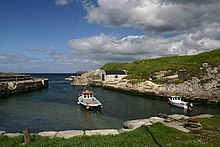 Ballintoy Harbour was Lordsport on the Iron Islands.
Ballintoy Harbour was Lordsport on the Iron Islands.
Third-season production returned to Dubrovnik, with the Walls of Dubrovnik, Fort Lovrijenac, and nearby locations again used for scenes in King's Landing and the Red Keep.[104] Trsteno Arboretum, a new location, is the garden of the Tyrells in King's Landing. The third season also returned to Morocco (including the city of Essaouira) to film Daenerys's scenes in Essos.[105] Dimmuborgir and the Grjótagjá cave in Iceland were used as well.[102] One scene, with a live bear, was filmed in Los Angeles.[106] The production used three units (Dragon, Wolf and Raven) filming in parallel, six directing teams, 257 cast members and 703 crew members.[107] The fourth season returned to Dubrovnik and included new locations, including Diocletian's Palace in Split, Klis Fortress north of Split, Perun quarry east of Split, the Mosor mountain range and Baška Voda farther south.[108] Thingvellir National Park in Iceland was used for the fight between Brienne and the Hound.[102] The fifth season added Seville, Spain, used for scenes of Dorne, and Córdoba.[109]
The sixth season, which began filming in July 2015, returned to Spain and filmed in Navarra, Guadalajara, Seville, Almeria, Girona and Peniscola.[110] Filming also returned to Dubrovnik, Croatia.[111] The filming of the seven episodes of season seven began on August 31, 2016, at Titanic Studios in Belfast, with other filming in Iceland, Northern Ireland and many locations in Spain,[112] including Seville, Cáceres, Almodovar del Rio, Santiponce, Zumaia and Bermeo.[113] Filming continued until the end of February 2017, as necessary, to ensure winter weather in some European locations.[114] Filming for season eight began in October 2017 and concluded in July 2018.[115][116] New filming locations included Moneyglass and Saintfield in Northern Ireland for "The Long Night" battle scenes.[117]
Effect on locations
Northern Ireland Screen, a UK government agency financed by Invest NI and the European Regional Development Fund, helped fund Game of Thrones.[118] Tourism Ireland has a Game of Thrones-themed marketing campaign similar to New Zealand's Tolkien-related advertising.[119][120] According to First Minister Arlene Foster, the series has given Northern Ireland the most publicity in its history apart from The Troubles.[121] The production of Game of Thrones and other TV series boosted Northern Ireland's creative industries, contributing to an estimated 12.4 percent growth in arts, entertainment and recreation jobs between 2008 and 2013 (compared with 4.3 percent in the rest of the UK during the same period).[122] After filming had finished, HBO converted its filming locations in Northern Ireland into tourist attractions to be opened in 2019.[123] By 2019, 350,000 visitors, or one sixth of all tourists, came to Northern Ireland annually because of Game of Thrones.[124]
Tourism organizations elsewhere reported increases in bookings after their locations appeared in Game of Thrones. Between 2014 and 2016, Hotels.com reported hotel bookings increased by 285 percent in Iceland and 120 percent in Dubrovnik.[125] In 2016, bookings doubled in Ouarzazate, Morocco, the location of Daenerys' season three scenes.[126] Dubrovnik also saw an increase in overnight tourist stays after episodes aired.[127] However, the increase in tourism driven by the series—estimated to be responsible for half of its annual increase over many years—led to concerns about "over-tourism" and its mayor imposing limits on tourist numbers in the city.[111][128] Following the series finale, HBO announced in April 2019 a new exhibition and tourist attraction containing show props and set pieces.[129] The attraction, titled Game of Thrones Studio Tour, will be located at former show filming location Linen Mill Studios outside Belfast.[130] Studies showed that the series had an overall positive economic impacts for both Northern Ireland and Dubrovnik.[131][132] Despite the positive economic results, some academics note the impact and damage from Game of Thrones–related tourist activities could have on historical sites and other locations of cultural value.[133]
Directing
Each ten-episode season of Game of Thrones had four to six directors, who usually directed back-to-back episodes.[134] Alan Taylor directed seven episodes, the most of any director.[135] Alex Graves, David Nutter, Mark Mylod, and Jeremy Podeswa directed six episodes each.[136] Daniel Minahan directed five episodes, and Michelle MacLaren, Alik Sakharov, and Miguel Sapochnik directed four each; MacLaren is the only female director of the entire series's run.[137] Brian Kirk directed three episodes during the first season, and Tim Van Patten directed the series's first two episodes.[138] Neil Marshall directed two episodes, both with large battle scenes: "Blackwater" and "The Watchers on the Wall".[139] Other directors include Jack Bender, David Petrarca, Daniel Sackheim, Michael Slovis and Matt Shakman.[140] David Benioff and D. B. Weiss have directed two episodes together but were credited with only one each, which was determined after a coin toss.[76] For season eight, David Nutter and Miguel Sapochnik, who worked on previous episodes, directed the first five episodes.[141] Benioff and Weiss were credited as both the writers and directors of the show finale "The Iron Throne".[142]
Production design
External videos HBO promotional video detailing the research and design of the show's costumes, YouTube video
HBO promotional video detailing the research and design of the show's costumes, YouTube video
Michele Clapton was the costume designer for Game of Thrones' first five seasons before she was replaced by April Ferry.[143] Clapton returned to the series as its costume designer for the seventh season.[144] For the first three seasons, Paul Engelen was Game of Thrones' main makeup designer and prosthetic makeup artist with Melissa Lackersteen, Conor O'Sullivan, and Rob Trenton. At the beginning of the fourth season, Engelen's team was replaced by Jane Walker and her crew, composed of Ann McEwan and Barrie and Sarah Gower.[145][146] Over 130 makeup artists and prosthetic designers worked on the show.[147][148]















































